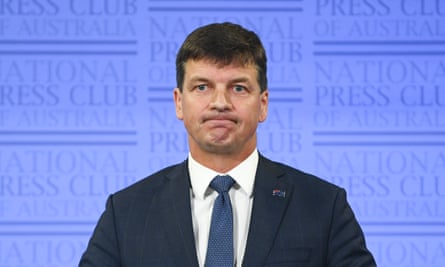Extract from The Guardian
Australians
are just expected to trust the minister and his advisers to
successfully pick winners deserving a crack at $18bn in taxpayers’ money

Last modified on Wed 23 Sep 2020 03.31 AEST
The first point to make about Angus Taylor’s low-emissions technology statement, launched on Tuesday as the Morrison government’s primary response to the climate crisis, is an obvious one: it would be terrific if it worked.
We should all hope the technologies that Taylor says the government will prioritise – hydrogen, energy storage, low emissions steel and aluminium, soil carbon and, yes, even the much-mocked carbon capture and storage (CCS) – come off and allow deep, rapid, sustainable cuts in greenhouse gas emissions.
Dealing with climate change is an unparalleled global challenge and any solution that can help address the problem should be embraced. Big claims have been made about the future of hydrogen, perhaps more than evidence to date can justify, but its potential applications across industry, manufacturing, transport and electricity are so great it is an obvious focus for research and development.
Similarly, taking steps to bring down the cost of energy storage is a no-brainer. The statement mentions the potential of pumped hydro, batteries and solar thermal. Cheap and varied storage options would, in theory, allow an accelerated take-up of renewable energy while reducing the reliance on the gas-fired power the government seems so keen to impose on the market.
The world needs affordable green steel production as quickly as it can get it, and the more carbon that can be sequestered in soils through improved farming practices the better.
CCS – capturing CO2 and burying it underground – is more problematic given its lengthy history of grand promises, taxpayer support for fossil fuel industries and lack of results. The statement’s suggestion it could be used in power generation seems fanciful given the international experience, but serious studies have found it is likely to be needed to play a role in industrial processes that are otherwise hard to deal with – so let’s not completely discard the idea.
The second point that should be made is less positive. While the technologies chosen may have varying degrees of merit, next-to-no evidence has been provided to explain how they were chosen, or why they are most deserving of a crack at $18bn in taxpayers’ money over the next decade. Instead, there are a series of unanswered questions.
It is not clear why they were preferred to other possibilities mentioned in the statement, including energy efficiency, electric vehicle charging infrastructure or steps to cut potent methane emissions. Based on Tuesday’s evidence, voters are just expected to trust Taylor and his handpicked advisers to successfully pick winners deserving of public support where others have failed.
The statement makes a series of big claims, including that it is anticipated the technologies will lead to Australia beating its 2030 climate target under the Paris agreement, help support more than 130,000 jobs and “avoid” 250m tonnes of emissions a year – nearly 50% of Australia’s current annual emissions – by 2040. No evidence has been released to back them up.
It sets “stretch goals” for each technology – the price point, Taylor says, at which technologies are cheaper than the more polluting alternatives used today. It is not clear how they will be met – there are no pricing mechanisms to drive technologies forward, no requirements for industry to adopt them – and the goals themselves do not come with a timeframe. A cynic might be tempted to think it was designed so the Coalition could never be accused of having failed.
The final, and perhaps most important, point to make is that the statement is not, by 2020 standards, really a climate change policy.
It makes no attempt to set a path to net zero emissions, let alone net zero by 2050, the underlying goal of the Paris agreement backed by scientific consensus, business leaders, farmers, unions and investors, and more than 100 countries.
The statement uses vague terms such as “clean” and “low emissions” technologies. Asked to define these terms, Taylor said they meant reducing emissions to below current levels. Without a concrete test – a low-emissions intensity standard or emissions reduction benchmark – it could be interpreted as suggesting a small improvement on today’s high-emitting levels would be enough. But it’s hard to know.
The statement does make clear that projects with the potential for significant greenhouse gas emissions, including hydrogen and steel made with gas, could win backing from public agencies created to lift renewable energy, assuming the government can convince the Senate to change the legislation for the Clean Energy Finance Corporation and the Australian Renewable Energy Agency.
It is possible there is a case for this – that using gas in the short term could help bring on the shift that would lead to fewer emissions overall. But it could be justified from a climate perspective only if it was part of a clear plan to get to renewably-based green hydrogen, steel and aluminium as quickly as possible.
Major investors believe that’s what global markets will want. The government has not said that’s where it wants to go and it continues to reject the sort of overarching policy – some form of carbon price – that experts maintain would help drive emissions cuts at lower cost.
Instead, the prime minister says he sees net zero emissions as an issue for the second half of the century, a more distant goal than nearly everyone (other than those on the anti-science far right) believes is necessary. And he just wants us to trust him.
No comments:
Post a Comment